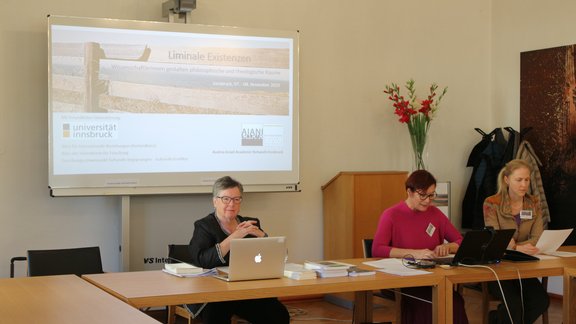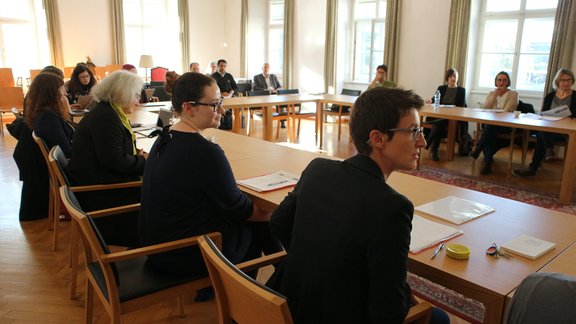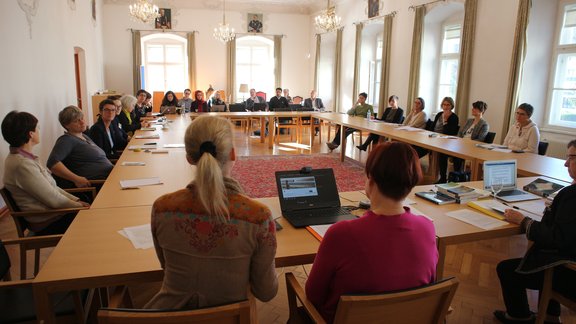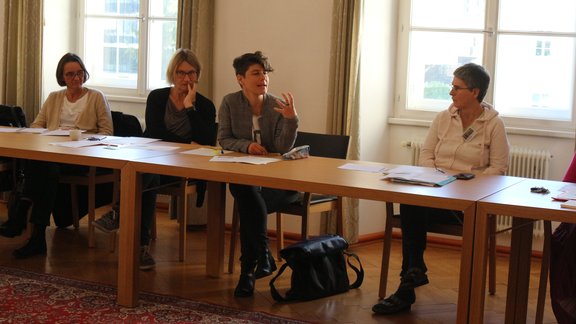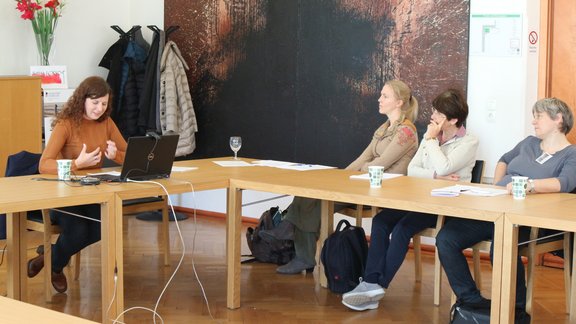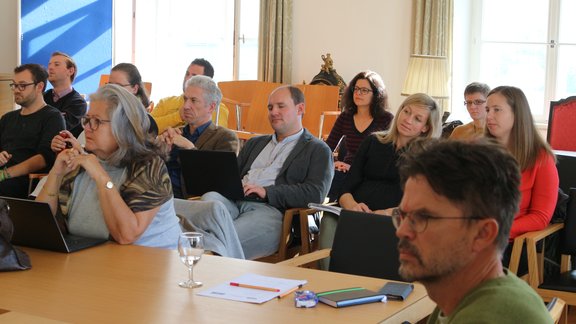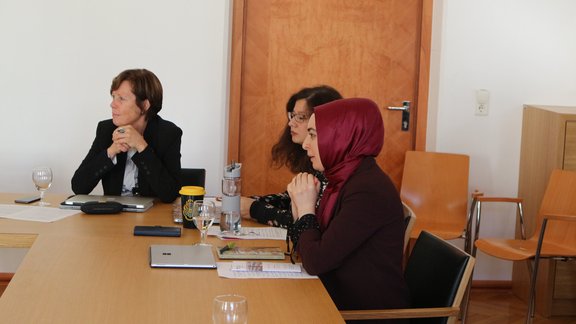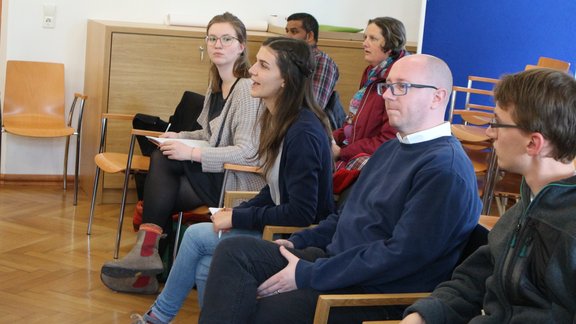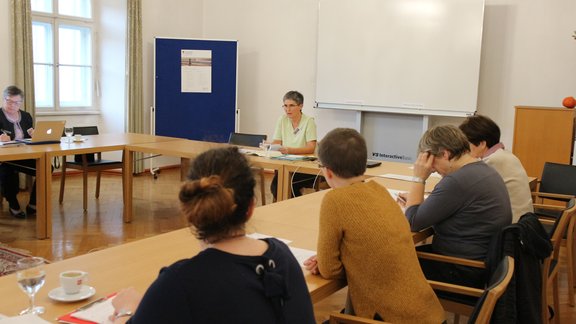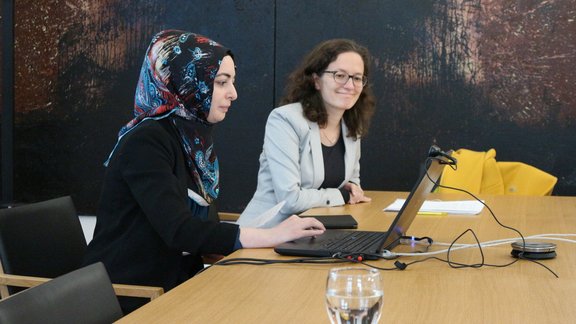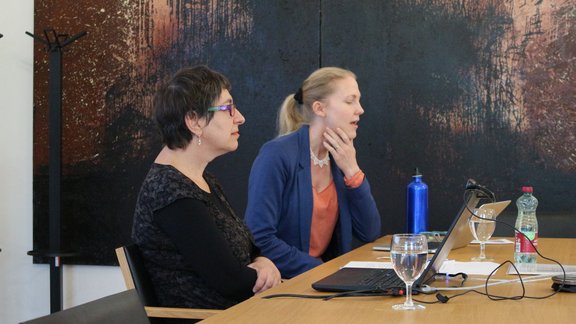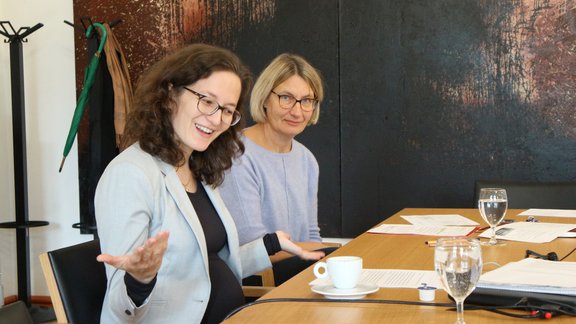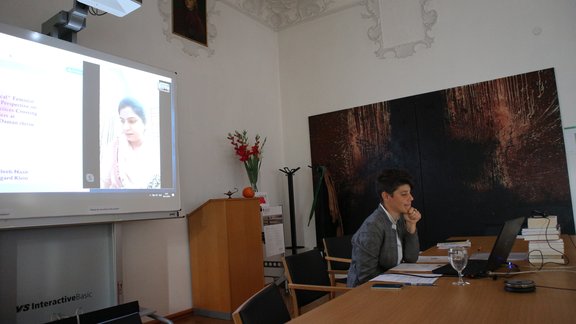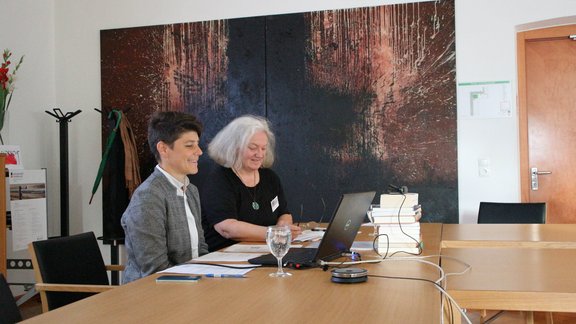
Tagung „Liminale Existenzen”
Donnerstag, 7. November 2019
09:00
Eintreffen
09:30
Martina Kraml | Katherine Dormandy (Universität Innsbruck) Begrüßung und Einführung
09:45–10:45
Mary Ann Hinsdale (Boston College):
Beyond Complementarity: Gender Issues in the Catholic Church
Gender Issues in the Catholic Church: “Getting Beyond” Complementarity1
Mary Ann Hinsdale, IHM, Ph.D – Boston College
“Liminale Existenzen” Tagung – University of Innsbruck – 7.11.19
I What do I mean by “liminality”?
II „Die Zeichen der Zeiten“ regarding “gender,“ “gender theory,“ “gender ideology“
- Gender as “performative“ and “fluid” (Judith Butler, et. al.)
- LGBTQA persons exist among the “People of God” (laity, clergy, hierarchy)
- Teachers in Catholic schools may not reveal their sexual orientation or marital state without jeopardizing their employment
- Legalization of same-sex marriage exists in many countries
- Pope Francis’s concerns, iterated in in-flight press conferences, in Amoris Laetitia (2016), # 54 (feminism is “a positive development,” “a work of the Spirit“ – though “certain forms are inadequate”; #56: “gender ideology“ is “a fundamental challenge to the family“ since it “denies the difference and reciprocity in nature of a man and a woman and envisages a society without sexual difference; and „it leades to educatioal programs that promote a personal identity and emotioal intimacy radically separated from biological difference“
- In meeting a transgender man in 2016, Pope Francis said, “We must be attentive, not saying all are the same, people must be accompanied, accompanied as Jesus accompanied.”2
- The most recent document (10 June 2019) from the Congregation for Education (“’Male and Female he created them’: Towards a Path of Dialogue on the Question of Gender Theory in Education”) is troubling (http://www.vatican.va/roman_curia/congregations/ccatheduc/documents/rc_con_ccatheduc_doc_20190202_maschio-e-femmina_en.pdf)
- What does this document signify? It purports to be a genuine invitation to “listen,” “dialogue” and “propose”? It does not preclude continuing conversation with science and has “points of agreement” with gender theory (e.g., vs. discrimination and bullying of sexual minorities), but in light of world-wide sexual abuse of women, is this enough?
- What are other “signs of the times” that need to be discerned in terms of the “liminal status of women in the church?
III A brief overview of magisterial pronouncements on gender and feminist critiques
The following “litany” of magisterial pronouncements is taken from my chapter on “A Feminist Reflection on Post-Conciliar Ecclesiology” in R. Gaillardetz and E. Hahnnenberg, eds., A Church With Open Doors: Catholic Ecclesiology for the Third Millennium.3 There I argue that “the issue under the issues” in ecclesiology today is gender “complementarity.” See especially, 118-128.
IV What are some possible alternatives?
A. Brianne Jacobs: presents an embodied ontology that begins with the body, holding on to the personalism of JPII, but rather than employing an a priori understanding of biological sex, argues that it is history that gives the body meaning and legibility in society. Thus, the body is an existential category. Jacobs appropriates ideas from Butler, Metz, and Copeland to enflesh her argument.4
B. Sarah Coakley: for Coakley, “desire” is the “constellating category of selfhood, the ineradicable root of one’s longing for God.”5 In making desire the more fundamental category, she shows that gender is not static, not fixed “into the seemingly immovable stuckness of what secular theory gloomily calls ‘the gender binary’. Rather, it is made redemptively labile—subject to endless reformulations one can scarcely imagine at the beginning of the spiritual journey. And this occurs precisely by its submission to something more fundamental: the interruptive desire of the trinitarian God for the fallen creation.”6
C. Cristina Traina: Discusses justice and gender in a global church in the context of ecclesiology and social justice, in “Whose Sensus? Which Fidelium?” which is a chapter in Learning from All the Faithful: A Contemporary Theology of the Sensus Fidei.7 She sheds some light on Pope Francis’s position in terms of his “decolonial” concerns
D. Benjamin Hohman: “Gender and Metaphysics: Judith Butler and Bernard Lonergan in Conversation” (forthcoming in Theological Studies)
V. For Discussion:
- How does this debate present a liminal existence for women and other minoritized persons in the church?
- Is not “Ideology” also a violent word? What kind of discourse makes one’s identity intelligible?
- The Amazon Synod has brought renewed hope for a more “synodal” church. What possibilities does this hold out for the liminal situation of women in the official teaching of the Catholic church?
1 I gave the title: “Beyond Complementarity: Gender Issues in the Catholic Church” to Martina Kraml over a year ago. This past June, Dr. Brianne Jacobs, a recent PhD graduate from Fordham University, now teaching at Emmanuel College in Boston published “An Alternative to Gender Complementarity: The Body as Existential Category in the Catholic Tradition.” Theological Studies 80 (June 2019), 328-345. I will reference her work in this paper to some extent.
2 Joshua J. McElwee, “Vatican office blasts gender theory, questions intentions of transgender people,” National Catholic Reporter, June 10, 2019, https:// ncronline.org
3 Collegeville, MN: The Liturgical Press, 2015, 112-137, especially pp. 118-129.
4 Brianne Jacobs, “An Alternative to Gender Complementarity,”
5 Sarah Coakley, God, Sexuality and the Self. (Cambridge: Cambridge University Press, 2013), 58.
6 Ibid., 59
7 Bradford E. Hinze and Peter C. Phan, eds., Learning from All the Faithful: A Contemporary Theology of the Sensus Fidei (Eugene, OR, 2016), 155-169. Also relevant is Bryan Massengale’s essay in the same volume: “Beyond ‘Whom Am I To Judge?’”: The LGBT Experience and Truth-Telling in the Catholic Church.” 170-183.
11:15–12:15
Nicole Bauer (Universität Innsbruck):
Weibliche Perspektiven in männerdominiertem Terrain:
Die Rolle der Forscherin in der ethnographischen Erkundung des katholischen Exorzismus-Feldes
Bei der Erforschung gegenwärtiger religiöser Gruppen stellen ethnographische Forschungsmethoden eine Möglichkeit dar, religiöse Praktiken und Gruppendynamiken in Augenschein zu nehmen, am eigenen Leib zu erfahren um diese von innen heraus beschreiben zu können. Die Teilhabe der Forschenden im religiösen Feld erfährt hier besondere Berücksichtigung. Durch die Adaption ethnographischer Forschungsmethoden in Theologie und Religionswissenschaft rückt die Rolle der Forscherin/des Forschers in den Fokus des Forschungsprozesses. Die Forscherin/der Forscher begibt sich mit allen Sinnen in das zu untersuchende Forschungsfeld und das Erleben findet somit im Forschungsprozess Berücksichtigung. Bei der Untersuchung marginaler religiöser Gruppen, wie dem Exorzismus-Feld, das bislang kaum Berücksichtigung in der Forschung fand, stellt die aktive Partizipation im Feld eine Möglichkeit dar, sich implizitem Wissen, das Handlungen und religiösen Praktiken zugrunde liegt, anzunähern. Die Reflexion der eigenen Rolle, sowie des Erlebens trägt dabei zum Verständnis von tieferliegenden Dynamiken in religiösen Gruppen bei und liefert hilfreiche Erkenntnisse insbesondere in Bezug auf Genderaspekte. Gleichzeitig kann die Forscherin-Rolle auch hinderlich sein, besonders in der ethnographischen Erkundung männerdominierter Felder. Vor diesem Hintergrund wird das Feld der römisch-katholischen Exorzisten mit besonderem Fokus auf die Rolle der Forscherin diskutiert.
12:15–13:00
Gespräch: Themenbezug Liminalität
14:30–15:30
Irmtraud Fischer (Universität Graz):
Liminale Exegetinnen: Frauen legten immer die Bibel aus – nur hat man das nicht tradiert
Lange Zeit wurde aufgrund der „spirituellen“ Tradition des 19. Jhds und der vorkonziliaren Theologie, die ein Lesen der Bibel ohne Anleitung von Geistlichen explizit nicht empfahl, behauptet, Frauen seien nie als Exegetinnen tätig gewesen. Historische Forschungen an der Rezeptionsgeschichte der Bibel erweisen das Gegenteil. Um die Exegesen der Frauen zu finden, muss man allerdings kreativ sein, denn sie sind nicht immer in Büchern zu finden wie etwa Christine de Pizans „Stadt der Frauen“ (und selbst diesen mittelalterlichen Bestseller hat man „vergessen“!), sondern sind etwa aus patristischer Briefliteratur, aus Verteidigungsschriften bei lehramtlichen Anklagen u.ä. zu finden. Aber auch heute noch fristen Exegetinnen teils eine liminale Existenz durch ihre Themen, Herangehensweisen und Verwendung von Methoden, die allesamt nicht dem Mainstream der Forschung folgen.
15:30–16:30
Mira Stare (Universität Innsbruck):
Die grenzüberschreitende Kraft des Magnificat und seines Kontextes
Das Lukasevangelium berichtet in der Form eines Diptychons über die wunderbare Empfängnis, die Geburt und die Kindheit von Johannes dem Täufer und Jesus. Mit dem Tempelpriester Zacharias werden seine Grenzen und sein Unglaube angesichts des Boten Gottes und dessen Worte gezeigt. Demgegenüber reagiert die junge Frau Maria aus Nazaret auf die Botschaft des Engels mit dem Glauben und lässt sich ganz auf die Worte Gottes ein. In der Begegnung mit ihrer Verwandten Elisabeth im Gebirge von Judäa überschreiten beide Frauen mit ihrem prophetischen Worten – insbesondere mit dem Magnificat Mariens – die Grenzen und Konventionen ihrer Zeit und weisen auf eine neue in Gott durch Jesus Christus veränderte Realität hin.
Liminale Existenzen. Wissenschaftlerinnen gestalten philosophische und theologische Räume
Katholisch-theologische Fakultät Innsbruck, 7. Nov. 2019
Die grenzüberschreitende Kraft des Magnificat und seines Kontextes
Mira Stare
Einleitung
1 Der Kontext des Magnificat
1.1 Das Proömium des Lukasevengeliums - Lk 1,1-4
1.2 Die Textstruktur des Diptychons in Lk 1,5-2,52 und die Positionierung des Magnifica
Lk 1,5-25 - Ankündigung der Geburt des Johannes vom Engel Gabriel an den Priester Zacharias im Tempel in Jerusalem während seines priesterlichen Diens
Lk 1,26-38: Ankündigung der Geburt Jesu vom Engel Gabriel an Maria in Nazareth
Lk 1,39-56: Der Besuch Marias bei Elisabet im Bergland von Judäa
Magnificat
Lk 1,57-58: Geburt des Johannes
Lk 1,59-80: Beschneidung und Namengebung
Benedictus
Lk 2,1-20: Geburt Jesu
Gloria
Lk 2,21: Beschneidung und Namengebung
Lk 2,22-40: Darstellung Jesu im Tempel
Nunc dimittis
Lk 2,41-52: Der Zwölfjährige im Tempel
1.3 Die erste Erscheinung des Engels Gabriel und die Ankündigung der Geburt des Johannes – Lk 1,5-25
1.4 Die zweite Erscheinung und Ankündigung: Die Ankündigung der Geburt Jesu – Lk 1,26-38
1.5 Der Vergleich der beiden Ankündigungsszenen
(1) Orte der Ankündigungen: Bei der ersten Erscheinung ist dieser Ort das Zentrum, nämlich der Tempel in Jerusalem, und bei der zweiten Erscheinung die unbedeutsame Stadt Nazareth in Galiläa.
(2) Adressaten der Ankündigungen: Auf der einen Seite ist das der gerechte, fromme und dienstvollbringende Tempelpriester Zacharias und auf der anderen Seite die junge Frau Maria.
(3) Die „unerwarteten“ Reaktionen: Der Unglaube bzw. die Unfähigkeit des Priesters Zacharias, sich auf das Wort des Engels Gabriel einzulassen gegenüber dem Glauben / dem Vertrauen der Maria, die dem Wort des Engels zustimmt und sich als Magd des Herrn zur Verfügung gibt: „Siehe, die Magd des Herrn. Es geschehe mir nach deinem Wort“ (Lk 1,38).
(4) Die Folgen: Solange der Priester Zacharias nicht zum Glauben gelangt, bleibt er stumm und hat nichts zu sagen. Demgegenüber besucht Maria, die sich auf die Worte des Engels einlässt, ihre Verwandte Elisabet und spricht ihren prophetischen Lobgesang, das Magnifikat.
2 Marias Besuch bei Elisabet und das Magnificat im Zentrum der lukanischen Kindheitsgeschichte Jesu – Lk 1,39-56
2.1 Maria besucht Elisabet – Lk 1,39-40
2.2 Elisabet und ihre prophetischen Worte und Seligpreisung – Lk 1,41-45
2.3 Mariens Lobgesang, das Magnificat – Lk 1,46-55
(1) Das Alte und das Neue – die Tradition und die Neuheit
Dieser Lobgesang Marias ist ein in der Gebetssprache ihres Volkes formulierter Lobgesang auf Gott. Es enthält Anklänge an das Alte Testament, besonders an den Lobgesang der Hanna (1 Sam 2,1-10).
(2) Gottes Handeln an Maria
Der erste Hauptteil des Magnificat lenkt den Blick auf den Gott, der an Maria Großes „tut“. Maria erkennt das großartige Handeln Gottes in ihrem Leben und dessen Bedeutung für die ganze Menschheit (für alle Generationen / Geschlechter).
(3) Gottes Heiligkeit und sein Erbarmen
Der „heilige“ Gott erweist seine Hoheit und Souveränität in besonderer Weise in seinem „Erbarmen“ (ἔλεος), in welchem er sich treu bleibt „zu Geschlechtern und Geschlechtern“.
(4) Gottes Handeln an der Menschheit
Im zweiten Hauptteil betrifft das Handeln Gottes (seine „Krafttat“) alle Menschen und wandelt radikal sogar die politisch-sozialen Verhältnisse.
(5) Prophetische Sichtweise und Visionen
(6) Gottes erbarmende und bleibende Zuwendung zu den Menschen
Was auch immer in der Geschichte seines Volkes sich ereignet, er hört nicht auf, der Erbarmende zu sein. Das entspricht seinem innersten Wesen (vgl. Ex 34,6-7). Das Erbarmen ist die Konstante Gottes schlechthin. Wie bisher wird sich Gott weiterhin um sein Volk und insbesondere um die „liminalen Existenzen“ kümmern und sie in die befreiende und heilende Transformation bringen.
3 Fazit – Ergebnisse und Reflexion
17:00–18:00
Amber Griffioen (Universität Konstanz):
Marginal Bodies, Liminal Minds: Women Mystics as Epistemic Heroes
In his development of a social epistemology of resistance, José Medina discusses those persons he calls “epistemic heroes”, or “extraordinary subjects who under conditions of epistemic oppression are able to develop epistemic virtues with a tremendous transformative potential”. Medina argues that such supererogatorily heroic figures can serve as emblems or exemplars who “epitomize the daily struggles of resistance of ordinary people”. The contributions of many medieval religious women thinkers labeled as ‘mystics’ have been largely erased from the history of philosophy. Yet their thought was not only far more historically influential than its present philosophical and theological reception would lead one to believe, the written work of these figures – as well as the stories of the women behind them – provide tools for political resistance and theological transformation even today. I will thus explore the ways in which these women represent epistemic heroes in Medina’s sense and argue for their incorporation into “standard” philosophical and theological canons.
19:00
Conference Dinner
Freitag, 8. November 2019
09:00
Einführung
09:10–10:10
Ranja Ebrahim (Universität Wien):
Weibliche Exegetinnen des Qur’an im 20. und 21. Jahrhundert und die Resonanz der Wissenschaftscommunity
Frauen und Exegese stellt ein verhältnismäßig neuartiges wissenschaftliches Spannungsfeld im Kontext der islamischen Theologie dar. Das Bestreben weiblicher Exegetinnen als Mainstream erachtet zu werden, wird trotz theologischer - weniger traditioneller- Legitimation immer noch als ein spezieller Bereich behandelt. Der Fokus der Exegetinnen liegt hauptsächlich darin: „to recover its anti patriarchal Epistemology“, also um ein Aufarbeiten männlich geprägter Lesungen, hin zu einer inklusiven Lesung, wodurch Frauen als aktive und kritische Stimmen im Deutungsprozess des Qurʼān partizipieren. Der Vortrag wird anhand von zwei Beispielen von Asma Barlas und Amina Wadud, die Strategien inklusiver Lesungen präsentieren.
10:10–11:10
Fatima Cavis (Universität Graz):
Marginalisierung der Frau in den islamischen Frauenkatechismen
The Islamic women's catechisms (turk. Kadın İlmihalleri) represent important written religious sources within the Turkish Islamic culture, especially in mosque teaching, but also in the domestic religious education of adolescent and adult Muslim women both in Turkey and in Europe. These are comparable to the catechisms within the Christian tradition, which are used as religious manuals in the introduction to the Christian faith. In contrast to general catechisms (ilmihal) Islamic women's catechisms are not restricted to including comprehensive knowledge about the core religious issues (faith, worship, ethics, interpersonal relationships), which is an obligation for an adult Muslim to understand. In addition, they also deal specifically with questions of religious law relating to the familial, social, economic, political and everyday life of Muslim women.
Because of their function as religious reference works, the Islamic women's catechisms are of outstanding importance in shaping the religious consciousness of the broad base. Therefore, an interdisciplinary content-related discussion with them is of great importance.
However, apart from a few studies on the general ilmihal books in Turkish, studies of Islamic women's catechisms in both Turkish and German-speaking countries are still lacking. This desideratum caused to analyze and discuss selected Islamic women's catechisms currently published in Turkey. In the context of a dissertation, the contents of 15 current Handbooks with regard to the social representation of women in the fields of education, politics, public positions such as head of state, in the judiciary as judge as well as witness and finally in view of their participation in communal rituals in cultic spaces are analyzed from the gender perspective.
The study showed that women's catechisms partially have serious substantive, methodical and formal deficits that massively jeopardize their suitability as religious manuals for a contemporary and gender-sensitive religious education.
After an insight into the Islamic women's catechisms this presentation seeks to introduce to and critically reflect on some of the fundamental problem areas of this Handbooks based on examples from the fields of public education and career of women from a gender perspective.
11:40–12:40
Nehama Verbin (Universität Tel Aviv):
Faith and the Absurd: Kierkegaard, Camus and Religious Protest
Religious protest, voiced in various sources and forms, from the book of Job and Ecclesiastes to Elie Wiesel, expresses the manners in which believers experience the absurd while hanging on to God. The purpose of the paper is to explore the "grammar" of this paradoxical faith stance by bringing Kierkegaard and Camus to bear upon it.
The paper has three parts. In the first, I discuss different religious experiences of the "absurd", appealing to Camus to shed light on some of their features. I distinguish between Qoheleth's nihilism and Job's religious protest, characterizing both as "experiences of the absurd".
In the second part, I engage with Kierkegaard's later Discourses in order to explore the ways in which "faith's thought" renders the experience of the absurd a religious one. I argue that, for Kierkegaard, "faith's thought", does not undo the absurd; it neither solves the paradox nor dissolves it. Rather, it adds a different dimension, a different perspective or aspect to it. Emphasizing Kierkegaard's insistence that we are to end with the paradox, however, I argue that despite what Camus had supposed, and despite what many of his and Kierkegaard's commentators had supposed, Kierkegaardian faith does not provide a way out of the absurd; rather, it pushes the believer further into it, while adding another dimension to it.
I end, in the third part, with a few comments about the bearing of these reflections on the "grammar" of "faith" and what they entail or do not entail concerning the relation between faith and reason.
14:00–15:00
Michaela Quast-Neulinger (Universität Innsbruck)
Renewal from Crisis: Towards an Analytic Assessment of Religious Responses to Transformational Challenges
15:00–16:00
Andleeb Nasir (Loyola Hall Research Center Lahore)
Irmgard Klein (Universität Innsbruck):
Doing „Glocal“ Feminist Theology: A Perspective on Religious Practices Crossing Borders
The shrine of Hazrat Bibi Pak Daman holds a great significance for hundreds of thousands of devotees in Punjab/Pakistan. This paper reflects on the implicite logics manifested in the experiences and collected texts of twelve of them from different cities. The findings of the study interpret the narrations of the devotees with the documentary method and from a feminist theological point of view between two key questions: are the religious practices helping to adjust to the patriarchal system (Mernissi)? Or can we perceive/elaborate aspects of transcending borders, widening limitations, even “devotional empowerment” (Ghadially)? We will explore an integration of both thesis. We frame this analysis of liminalities transported in devotional narratives at Bibi Pak Daman shrine through a meta-reflection. We argue for borrowing insights from communicative theologizing for a possible shape of doing feminist theology in Asia in the tension between the local and the global rationale (Kang).
Doing "Glocal" Feminist Theology - a Perspective on Religious Practices Crossing Borders
(at Hazrat Bibian Pak Daman - shrine/Lahore)
Andleeb Nasir (Lahore) / Irmgard Klein (Innsbruck)
Introduction
„My search for emancipatory knowledge over the years has made me realize that ideas are always communally wrought, not privately owned.“ Chandra Talpade Mohanty
“In my soul there is a temple, a shrine, a mosque, a church where I kneel. Prayer should bring us to an altar where no walls or names exist.” Rabia Al Basri
1. Communicative theological approach – challenge of doing glocal feminist theology
How can the collected semi-structured interviews and the ethnographic field notes provide theology? How can we justify a new interpretation under a critical Asian feminist eye? What are the dangers and troubles in doing glocal theological research?
Communicative theological understanding: Experiences and even more, shared experiences are a theological place, a “locus theologicus” = a “domicile”, a “residence” for (theological) insight and findings, for God-talk. (Melchior Cano, Seckler, Hünermann, Körner ...)
Glocal feminist theology – struggeling with the globe: Christian feminist theology unfolded in diverse strands and traditions. – Womanist theology as African American Women’s thought, Mujerista/Chicana/Latina-theology for Latin American Theology –,
“Asian Feminist Theology” in the Asias / authentic and local tradition = “a nostalgic romanticizing of one's heritage or tradition“ (Kwok 2005:30)
„under-/mis-representation of the tremendously diverse reality of Asian women themselves“ (Kang 2008:207)
universal narrative as discriminated victims vs. “the difference dilemma.”(Kim 2005:83)
respond „to the increasing forces of globalization [...] under which “my/our comfort” is often maintained at the expense of “somebody else’s” and vice versa. It is also an effort to form global resistance against ongoing injustice and global solidarity among wo/men in and across national borders.“ (Kim 2005:76–77)
‘I am because we are; and we are because I am.’ (Kang 2008:223) ‘in-between consciousness’ (Kang 2008:224)
2. Introduction to the place - contextualisation
Women shrines in Sindh and Punjab (Shia - Sufi)
Hagiographic Legend of Foundation of Hazrat Bibian Pak Daman (the „chaste“ ladies)
A place for everyone
Description of devotion
Urs and devotional times
Devotees – public
Devotional practices
3. Ethnographic fieldwork at the shrine
Methodology of research – data collection
semi-structured interviews and participant observation
based on convenience sampling
Research size and population
12 participants/8 females and 4 males/age from 14 to 65 years.
from Faisalabad, Gujranwala, Lahore, Multan, Sargodha and Sialkot.
Data collection procedure
three weeks // collecting in four phases;
Selected portrays of devotees interviews
D2: (Sunni 35 years old, female teacher, Lahore)
D4: (Female 55 years old, Multan)
D7: (Female Christian 28 years old, Sargodha)
D9: (female 24 years old, unknown place)
Symbols and their interpretations according to the devotees
Rose Garlands, Rose Petals, Flower Sheets, Kheer, Halwa, Sweets, Salt, Lock, Threads, Burning Incense and Diya
4. Findings/Results: Religious practices crossing/establishing borders under feminist critique
Mernissi: “Women, Saints and Sanctuaries” Maroccos numerous shrines
“Saints, then, help women adjust to the oppression of the system." (Mernissi 1977:112)
Ghadially: muslim minority in South Asia, the bohras
Devotional empowerment „perceived possibilities for freedom and agency.“ (Ghadially 2016:99)
Method of analysis and (re)constructing the interpretation
The documentary method (Nohl 2017)
habitual action and atheoretical knowledge
immanent meaning (text surface)
documentary meaning (shared experiences, horizon of collective knowledge)
limited relativistic and constructivist position
Aspects that remain within boundaries
- Focus on the reproductive relationship and task of women
- Central position of male offspring
- Disguising and concealing problems (of violence) - Relationship issues
Aspects that transcend boundaries
- Presence of the saint in an individual-transreligious way - without religious limit, without age limit, without social limit.
- Power in fainting situations – empowerment
- Veneration of women - the representation of the holy is feminine
- Matrilinear/feminine relationship network
- The devotional practices are physical (eating, offering children, touching the horse, mehndi) and reach into the spiritual sphere
- Individuals transcend their individual selves and work for the benefit of the community
CONCLUSION
more dense findings towards transcending boundaries (Ghadially) vs. iron laws of fixed, essentialist, biological role-marks in the collective experience-space underlying the narrations D1-D12.
16:15–17:00
Abschluss der Tagung
Einladung als PDF (nicht barrierefrei)

